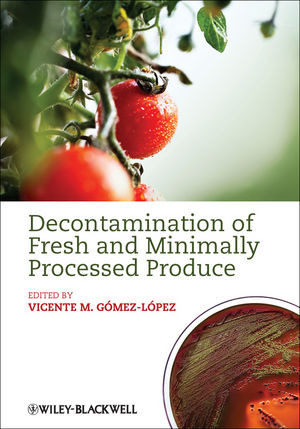Decontamination Of Fresh And Minimally Processed Produce Vicente M Gmezlpez by Vicente M. Gómez-lópez 9780813823843, 9781118229187, 0813823846, 1118229185 instant download after payment.
Attempts to provide safer and higher quality fresh and minimally processed produce have given rise to a wide variety of decontamination methods, each of which have been extensively researched in recent years.
Decontamination of Fresh and MinimallyProcessed Produce is the first book to provide a systematic view of the different types of decontaminants for fresh and minimally processed produce. By describing the different effects – microbiological, sensory, nutritional and toxicological – of decontamination treatments, a team of internationally respected authors reveals not only the impact of decontaminants on food safety, but also on microbial spoilage, vegetable physiology, sensory quality, nutritional and phytochemical content and shelf-life. Regulatory and toxicological issues are also addressed. The book first examines how produce becomes contaminated, the surface characteristics of produce related to bacterial attachment, biofilm formation and resistance, and sublethal damage and its implications for decontamination. After reviewing how produce is washed and minimally processed, the various decontamination methods are then explored in depth, in terms of definition, generation devices, microbial inactivation mechanisms, and effects on food safety. Decontaminants covered include: chlorine, electrolyzed oxidizing water, chlorine dioxide, ozone, hydrogen peroxide, peroxyacetic acid, essential oils and edible films and coatings. Other decontamination methods addressed are biological strategies (bacteriophages, protective cultures, bacteriocins and quorum sensing) and physical methods (mild heat, continuous UV light, ionizing radiation) and various combinations of these methods through hurdle technology. The book concludes with descriptions of post-decontamination methods related to storage, such as modified atmosphere packaging, the cold chain, and modeling tools for predicting microbial growth and inactivation.
The many methods and effects of decontamination are detailed, enabling industry professionals to understand the available state-of-the-art methods and select the most suitable approach for their purposes. The book serves as a compendium of information for food researchers and students of pre- and postharvest technology, food microbiology and food technology in general. The structure of the book allows easy comparisons among methods, and searching information by microorganism, produce, and quality traits.
Content:
Chapter 1 Microbial Ecology (pages 1–41): Marilyn C. Erickson
Chapter 2 Surface Characteristics of Fresh Produce and their Impact on Attachment and Removal of Human Pathogens on Produce Surfaces (pages 43–57): Hua Wang, Bin Zhou and Hao Feng
Chapter 3 Biofilms (pages 59–75): Shin?Hee Kim and Cheng?I Wei
Chapter 4 Resistance and Sublethal Damage (pages 77–86): Pascal Delaquis and Susan Bach
Chapter 5 Produce Washers (pages 87–103): Steven Pao, Wilbert Long, Chyer Kim and D. Frank Kelsey
Chapter 6 Minimal Processing (pages 105–120): Maria I. Gil and Ana Allende
Chapter 7 Chlorine (pages 121–133): Cristobal Chaidez, Nohelia Castro?del Campo, J. Basilio Heredia, Laura Contreras?Angulo, Gustavo Gonzalez–Aguilar and J. Fernando Ayala–Zavala
Chapter 8 Electrolyzed Oxidizing Water (pages 135–164): Muhammad Imran Al?Haq and Vicente M. Gomez?Lopez
Chapter 9 Chlorine Dioxide (pages 165–175): Vicente M. Gomez?lopez
Chapter 10 Ozone (pages 177–195): Hulya Olmez
Chapter 11 Hydrogen Peroxide (pages 197–214): Dike O. Ukuku, Latiful Bari and Shinichi Kawamoto
Chapter 12 Peroxyacetic Acid (pages 215–223): Gustavo Gonzalez?Aguilar, J. Fernando Ayala?Zavala, Cristobal Chaidez?Quiroz, J. Basilio Heredia and Nohelia Castro?del Campo
Chapter 13 Essential Oils for the Treatment of Fruit and Vegetables (pages 225–246): Catherine Barry?Ryan and Paula Bourke
Chapter 14 Edible Films and Coatings (pages 247–275): Maria Alejandra Rojas?Grau, Laura Salvia?Trujillo, Robert Soliva?Fortuny and Olga Martin?Belloso
Chapter 15 Miscellaneous Decontaminants (pages 277–282): Vicente M. Gomez?Lopez
Chapter 16 Bacteriophages (pages 283–295): Manan Sharma and Govind C. Sharma
Chapter 17 Protective Cultures (pages 297–316): Antonio Galvez, Ruben Perez Pulido, Hikmate Abriouel, Nabil Ben Omar and Maria Jose Grande Burgos
Chapter 18 Bacteriocins (pages 317–332): Antonio Galvez, Rosario Lucas, Hikmate Abriouel, Maria Jose Grande Burgos and Ruben Perez Pulido
Chapter 19 Quorum Sensing (pages 333–344): Maria S. Medina?Martinez and Maria Angelica Santana
Chapter 20 The Use of Mild Heat Treatment for Fruit and Vegetable Processing (pages 347–363): Catherine Barry?Ryan
Chapter 21 Continuous UV?C Light (pages 365–378): Vicente M. Gomez?lopez
Chapter 22 Ionizing Radiation (pages 379–405): Xuetong Fan
Chapter 23 Miscellaneous Physical Methods (pages 407–416): Vicente M. Gomez?Lopez
Chapter 24 Hurdle Technology Principles Applied in Decontamination of Whole and Fresh?Cut Produce (pages 417–449): Maria S. Tapia and Jorge Welti?Chanes
Chapter 25 Modified Atmosphere Packaging (pages 451–467): Matteo Alessandro Del Nobile, Amalia Conte, Marianna Mastromatteo and Marcella Mastromatteo
Chapter 26 Cold Chain (pages 269–484): Pramod V. Mahajan and Jesus Frias
Chapter 27 Modeling Microbial Responses During Decontamination Processes (pages 485–528): Eva Van Derlinden, Astrid M. Cappuyns, Laurence Mertens, Jan F. Van Impe and Vasilis P. Valdramidis
Chapter 28 Modeling Microbial Growth (pages 529–539): Milena Sinigaglia, Maria Rosaria Corbo and Antonio Bevilacqua


